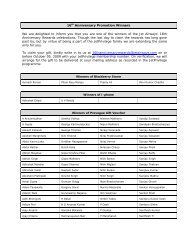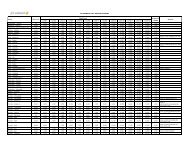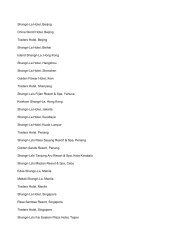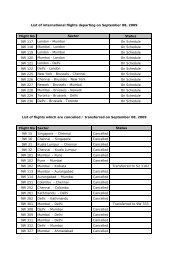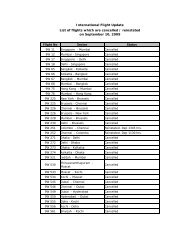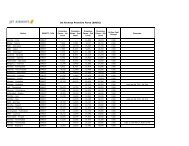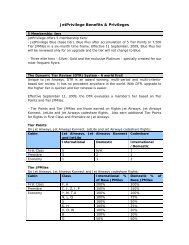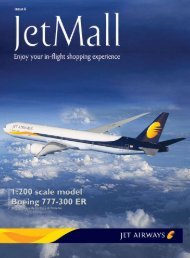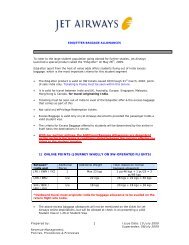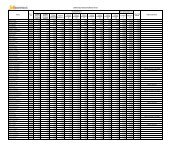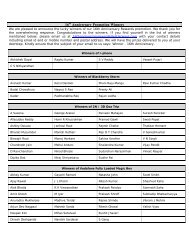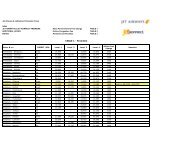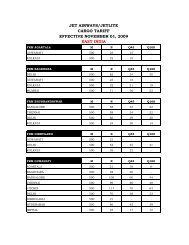Annual Report cb smile - Jet Airways
Annual Report cb smile - Jet Airways
Annual Report cb smile - Jet Airways
You also want an ePaper? Increase the reach of your titles
YUMPU automatically turns print PDFs into web optimized ePapers that Google loves.
Significant Accounting Policies and Notes forming part of Consolidated Accounts (contd.)<br />
J. DEPRECIATION / AMORTISATION:<br />
a) Depreciation on tangible fixed assets has been provided at the rates and in the manner prescribed under the<br />
schedule XIV to the Companies Act, 1956 on Written Down Value method, other than Narrow and Wide Body<br />
aircraft which are depreciated on Straight Line method. Expenditure incurred on improvements of assets<br />
acquired on operating lease is written off evenly over the balance period of the lease. Premium on leasehold<br />
land is amortised over the period of lease.<br />
b) On amounts added on revaluation, depreciation is charged over the residual life and the additional charge of<br />
depreciation is withdrawn from the Revaluation Reserve.<br />
c) Intangible assets are amortised on straight line basis as follows.<br />
i) Landing Rights acquired are amortised over a period not exceeding 20 years. Amortization period exceeding<br />
10 years is applied considering industry experience and expected asset usage.<br />
ii) Trademarks are amortised over 10 years.<br />
iii) Computer Software is amortised over a period not exceeding 36 months.<br />
K. INVESTMENTS:<br />
Current Investments are carried at lower of cost and quoted / fair value. Long Term Investments are stated at cost.<br />
Provision for diminution in the value of long term investments is made only if such a decline is other than<br />
temporary.<br />
L. BORROWING COSTS:<br />
Borrowing costs attributable to the acquisition or construction of a qualifying asset are capitalised as part of the<br />
cost of such assets. A qualifying asset is one that necessarily takes substantial period of time to get ready for<br />
intended use. All other borrowing costs are recognised as an expense in the period in which they are incurred.<br />
M. FOREIGN CURRENCY TRANSACTIONS / TRANSLATION:<br />
a) Transactions in foreign currencies are recorded at the exchange rates prevailing on the date of transaction.<br />
Monetary items are restated at the period-end rates.<br />
b) In case of holding company the exchange difference between the rate prevailing on the date of transaction<br />
and on the date of settlement / restatement (other than those relating to long term foreign currency monetary<br />
items) is recognized as income or expense, as the case may be. Exchange differences relating to long term<br />
foreign currency monetary items, to the extent they are used for financing the acquisition of fixed assets are<br />
added to or subtracted from the cost of such fixed assets and in other cases accumulated in ‘Foreign Currency<br />
Monetary Item Translation Difference Account’ and amortized over the balance term of the long term monetary<br />
item or 31st March, 2011 whichever is earlier.<br />
c) In case of subsidiary company the exchange difference between the rate prevailing on the date of transaction<br />
and on the date of settlement as also on translation of monetary items at the end of the year including those<br />
relating to long term foreign currency monetary items is recognised as income or expense, as the case may be.<br />
d) In case of forward exchange contracts entered into to hedge the foreign currency exposure in respect of<br />
monetary items, the difference between the exchange rate on the date of such contracts and the year end rate<br />
is recognized in the Profit and Loss Account. Any profit / loss arising on cancellation of forward exchange<br />
contract is recognized as income or expense of the year. Premium / discount arising on such forward exchange<br />
contracts is amortised as income / expense over the life of contract.<br />
N. INVENTORIES:<br />
Inventories are valued at cost or Net Realisable Value (NRV) whichever is lower. Cost of inventories comprises of<br />
all costs of purchase and other incidental cost incurred in bringing them to present location and condition. Cost<br />
is determined using the Weighted Average formula. In respect of reusable items such as rotables, galley equipment<br />
and tooling etc., NRV takes into consideration provision for obsolescence and wear and tear based on the estimated<br />
useful life of the aircraft derived from Schedule XIV of the Companies Act, 1956 and also provisioning for non –<br />
moving / slow moving items.<br />
102




